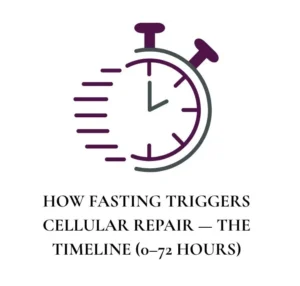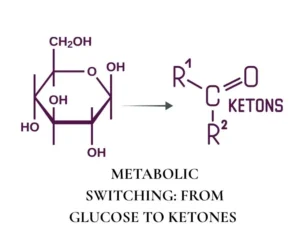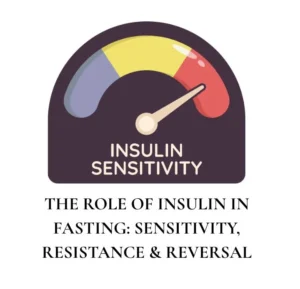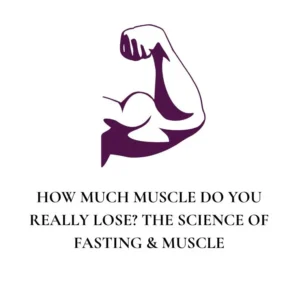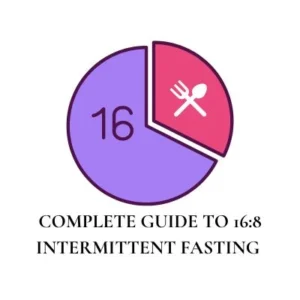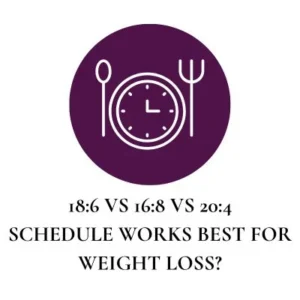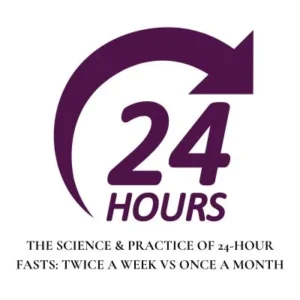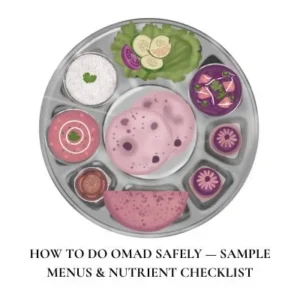There comes a moment when you realize your body is asking for a break — not from work or life, but from food.
You’re not sick. You’re just tired of the noise:
Table of Contents
Togglethe snacks, the cravings, the constant need to eat something.
And maybe, somewhere deep down, you’ve started wondering —
“What if my body doesn’t need more food right now? What if it needs space to heal?”
That’s where fasting begins.
At Vaidikway, fasting isn’t a challenge or a trend.
It’s a quiet conversation between you and your body — a way to return to your natural rhythm.
To feel light, clear, and peaceful again.
If you’ve never fasted before, this 7-day beginner plan will gently walk you into it — step by step — helping you reconnect with your inner wisdom and natural energy.
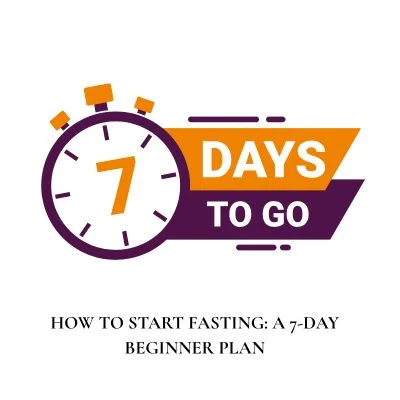
🕉️ What Is Fasting, Really?
Fasting is not starvation.
It’s the intentional resting of your digestive system — giving your body time to cleanse, repair, and reset.
Every system in nature follows cycles of activity and rest — day and night, inhale and exhale, growth and stillness.
But we eat all the time — from sunrise to midnight — leaving no room for the body to rejuvenate.
Fasting restores that balance.
It’s not about eating less — it’s about allowing more space for healing.
🔬 The Science Behind Fasting
When you stop eating for several hours, your body shifts from digestion to regeneration.
- Insulin drops → Your body burns stored fat for fuel.
- Inflammation decreases → The immune system calms down.
- Autophagy activates → Old, damaged cells are recycled.
- Digestive enzymes rest → Healing and detoxification begin.
- Mental clarity improves → Stable energy and fewer cravings.
It’s not magic — it’s biology in balance.
Your body already knows how to heal. You just have to give it the time.
🌞 Before You Start — Mindset Matters
Don’t jump into fasting with fear or pressure.
Approach it like a practice of self-awareness, not self-denial.
✨ Remember:
- Fasting is not a punishment for overeating.
- It’s not a crash diet.
- It’s not about control — it’s about connection.
When you fast with respect, your body cooperates. When you fast with anxiety, it resists.
So, take a deep breath.
This week is not about perfection — it’s about alignment.
🗓️ Your 7-Day Beginner Plan
This plan gently introduces your body to fasting. You’ll ease in slowly — not by skipping meals abruptly, but by creating peaceful gaps between them.
Each day builds on the previous one.
🌿 Day 1: Awareness Day
Goal: Observe your current eating pattern.
- Don’t change anything yet.
- Just note when you eat, what triggers you to eat, and when you actually feel hungry.
- Notice emotional or boredom eating.
🪷 Vaidikway Reflection:
Ask yourself — “Am I hungry, or just seeking comfort?”
🌿 Day 2: Reduce Night Eating
Goal: Stop eating 3 hours before bed.
If you sleep at 10 PM, finish dinner by 7 PM.
This single change can improve digestion, sleep, and morning energy.
🪷 Why: Nighttime is for detox, not digestion. When you stop eating early, your body gets hours of repair.
🌿 Day 3: 12-Hour Fast (Simple Reset)
Goal: Practice your first fasting window — 12 hours.
Example:
- Finish dinner at 7 PM
- Eat breakfast at 7 AM
Avoid snacking late night or early morning.
Sip water or herbal tea if needed.
🪷 Tip: Your body has already been doing mini fasts while sleeping — this is just being mindful of it.
🌿 Day 4: 14-Hour Fast (Gentle Challenge)
Goal: Extend fasting window slightly — 14 hours.
Example:
- Dinner at 7 PM
- Breakfast at 9 AM
You’ll begin to feel mild hunger — that’s natural. It’s your metabolism adjusting.
Stay hydrated and breathe through it.
🪷 Vaidikway Mantra:
“Hunger is not an emergency. It’s energy shifting.”
🌿 Day 5: 16:8 Intermittent Fasting
Goal: Begin the classic rhythm — 16 hours fasting, 8 hours eating.
Example:
- Eat from 9 AM – 5 PM
- Fast from 5 PM – 9 AM
In this window, your body activates autophagy, burns stored fat, and calms inflammation.
🪷 Food Guidance:
- Break your fast with fresh fruit or soup
- Eat balanced meals — protein, good fat, fiber
- Avoid sugar and refined carbs
🌿 Day 6: Deep Listening Day
Goal: Stay in 16:8 but observe your emotions and energy.
- Are you calmer?
- Are cravings reducing?
- Is your sleep improving?
If you feel fatigued, eat earlier.
If you feel light and clear, maintain your window.
🪷 Vaidikway Practice:
Write one paragraph in your journal about how your body feels today — not your weight, your energy.
🌿 Day 7: The Reflection Fast
Goal: Fast with awareness for 16–18 hours, consciously.
Spend the day in simplicity — light walks, gentle yoga, hydration, and quiet reflection.
Break your fast with gratitude. Eat slowly, chew mindfully.
Feel the difference — the calm, the clarity, the confidence.
🪷 Vaidikway Thought:
“This isn’t about skipping food. It’s about rediscovering peace in the pauses.”
🧠 What to Eat (and Not Eat) During the Week
✅ Eat More Of:
- Whole fruits & vegetables
- Lentils, sprouts, eggs, paneer, tofu
- Healthy fats (ghee, olive oil, nuts, seeds)
- Herbal teas, lemon water, coconut water
🚫 Avoid:
- Refined sugars and packaged snacks
- Sugary drinks
- Late-night eating
- Mindless munching out of boredom
💧 Hydration Checklist
Fasting doesn’t mean dryness — it’s actually a time to hydrate deeply.
Drink throughout the day:
- Plain or warm water
- Lemon water with pink salt
- Green tea, cinnamon tea, hibiscus, or mint infusions
- Coconut water (only during eating window)
🍵 How to Break a Fast Gently
The first thing you eat after fasting determines how your body responds.
Best foods to break a fast:
- 1 bowl of fruit (papaya, apple, or banana)
- 1 cup of vegetable soup or broth
- Light home-cooked meal (dal, rice, veggies, ghee)
Avoid:
- Coffee or tea on an empty stomach
- Heavy, spicy, or fried food
💬 Imagine your digestive system like a guest waking up from rest — greet it gently, not with a shock.
🧾 Simple Vaidikway 7-Day Meal Framework
Day | Fasting Window | Ideal Meals |
1 | Observe | Eat normally, stay mindful |
2 | 12 hrs | Early dinner, light breakfast |
3 | 12 hrs | Add soup or smoothie breakfast |
4 | 14 hrs | Two balanced meals |
5 | 16 hrs | 2 full meals + 1 fruit/snack |
6 | 16 hrs | Same as Day 5, but lighter dinner |
7 | 16–18 hrs | Smoothie or khichdi to break fast |
⚠️ Common Beginner Mistakes
- Starting too aggressively → causes fatigue or mood swings.
- Not drinking enough water → leads to headaches.
- Skipping electrolytes → makes you feel dizzy.
- Overeating after fasting → slows digestion.
- Judging yourself → breaks the spiritual essence of fasting.
✨ Remember — fasting is not about control, it’s about compassion.
🧬 What You’ll Notice by Day 7
By the end of your first week:
- Your bloating will reduce.
- Your morning clarity will increase.
- Your cravings will quiet down.
- You’ll start feeling in control of your hunger — not the other way around.
These are early signs that your metabolic switch is turning on — your body is learning to burn fat for energy.
And most beautifully, you’ll feel a subtle peace — the silence between meals becomes healing.
🌙 Beyond 7 Days — Your Next Step
Once you complete this plan, you can:
- Continue 16:8 daily
- Try one 24-hour fast per week
- Or experiment with 18:6 if comfortable
Don’t rush it.
Fasting is like a friendship — it deepens over time, not overnight.
💫 The Vaidikway Philosophy — Healing Without Hurry
At Vaidikway, we don’t count calories; we count moments of awareness.
We don’t chase discipline; we cultivate rhythm.
This 7-day plan is not just a schedule — it’s a mirror.
It shows you how deeply your body loves peace once you stop interrupting it with constant food.
Because fasting is not about not eating.
It’s about learning when enough is enough.
🌿 Ready to Begin Your Healing Journey?
Start your fasting practice with confidence and guidance.
Let your first week be the beginning of something permanent — balance, lightness, and clarity.
👉 Start Your Vaidikway Beginner Program
Your body already knows how to heal — we just remind it how.


